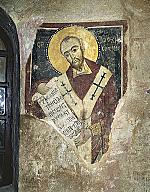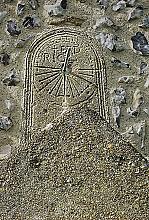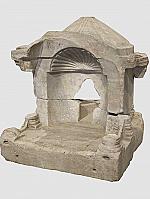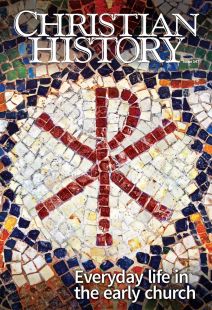“What God has joined together”
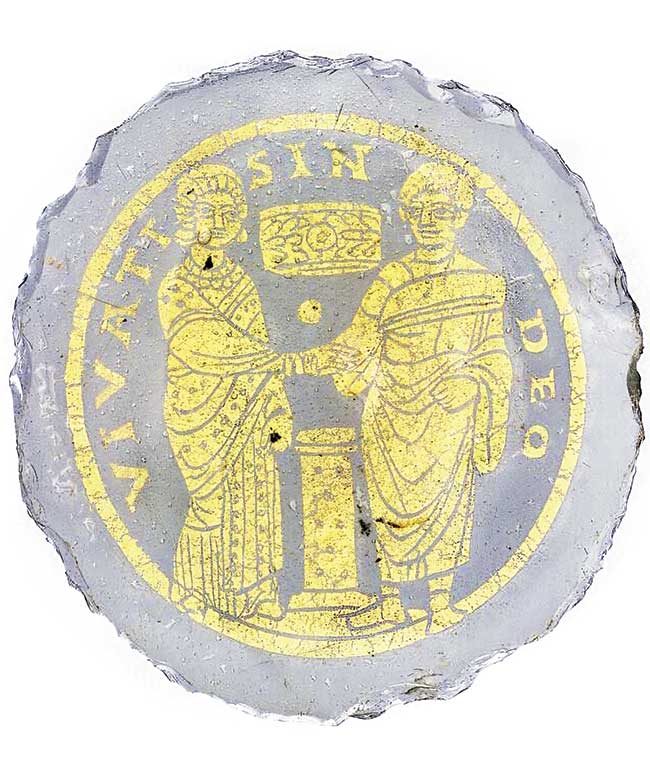
[Bowl Base with a Marriage Scene, 4th to 5th century Roman or Byzantine. Glass, gold leaf—Image copyright © The Metropolitan Museum of Art. Image source: Art Resource, NY]
A pagan convert to Christianity in its first centuries would have found his or her life changed in significant ways. Abstaining from traditional practices of animal sacrifice offered before images of the gods would have severed social ties with the local community.
Withdrawal from other aspects of civic life—public entertainments, gladiatorial combats, and the theater—would have furthered a new Christian’s sense of estrangement from Roman culture. But the factor that would have had the most dramatic impact was Christianity’s stricter standards of sexual morality within marriage.
The good of marriage
Around the year 400, Augustine of Hippo (354–430) penned a short treatise titled “The Good of Marriage” (De bono coniugali). In it he sketched what would become classic Christian teaching, at least in the Western church, on the “goods” found in marriage: procreation, the sexual fidelity of the marital relationship, and the permanence of the marriage bond, which Augustine called its “sacrament.” The last of these goods formed the basis of his conviction that neither separation nor divorce could sever a couple’s unity. Only the death of one of the spouses could end the marriage and allow for remarriage. Augustine believed that this strict view was the evident meaning of Ephesians 5:31–32:
For this reason a man shall leave his father and mother and be joined to his wife, and the two shall become one flesh [Gen. 2:24]. This mystery is a profound one, and I am saying that it refers to Christ and the church.
The Greek word for “mystery” (mysterion) was rendered in the Latin Bible as sacramentum, which to Augustine meant a “symbol.” Christian marriage contains a “sacrament,” Augustine would say, in the sense that it symbolizes something beyond itself, and that “something” is the union of Christ and the church. In his Literal Commentary on Genesis, composed about the same time as “The Good of Marriage,” he summarized the same argument neatly:
This good of marriage is threefold: fidelity, offspring, sacrament. Fidelity means that there are no sexual relations with another person outside of the marriage bond; offspring means that the children are to be received with love, nourished with kindness, educated in the faith; sacrament means that the marriage bond is not to be broken and that the divorced man or divorced woman may not be joined to another, even for the sake of producing children.
Augustine’s influential teaching on the indissolubility of marriage represents the weaving together of texts and traditions that had developed gradually during the earliest Christian centuries.
Marriage, in the perspective of most ancient cultures, was a stubbornly “worldly” institution. Its usual by-products—the production of legitimate children and the establishment of households—seemed to be the natural foundation of a well-ordered city, state, and cosmos. In theory at least, the paterfamilias was the undisputed master or dominus in a Roman household, whose word was law and whose “fatherly power” (patria potestas) extended even to matters of life and death.
Christians adopted some of these structures, but they also transformed them. Colossians 3:18–4:1, for example, forms a clear statement of the Christian appropriation of the structures of the Roman household, even the inherently brutal institution of slavery. Nevertheless, even within Colossians a subtle critique and realignment of familial relationships exists.
The passage outlines mutual responsibilities: wives are told to submit, but husbands are told to love; children are told to obey, but fathers are told not to provoke; slaves are told to obey and serve, but masters are told to treat their slaves justly. While one might question the extent to which Christianity actually altered domestic institutions such as slavery, Paul’s confidence in Philemon may give reason for optimism.
A higher view
From the very beginning, Christian sources departed from the views of marriage and divorce they had inherited from Greco-Roman tradition and the Hebrew Bible, which viewed divorce and remarriage as relatively unproblematic. All three of the synoptic Gospels preserve sayings of Jesus regarding the impermissibility of divorce. In Mark’s version Jesus responds to Pharisees who state that the Mosaic law allows a man to divorce his wife:
Because of your hardness of heart [Moses] wrote this commandment for you. But from the beginning of creation God made them male and female [Gen. 1:27]. For this reason a man shall leave his father and mother and be joined to his wife, and the two shall become one flesh [Gen. 2:24]. So, they are no longer two, but one flesh. Therefore what God has joined together, let no one separate [Mark 10:5–9].
Jesus’s teaching on the indissolubility of marriage seems to have been closely linked to his eschatological preaching. Those entering the kingdom of God were expected to manifest the holiness and perfection characteristic of God’s original creation, and this was understood to include monogamous unions.
The Gospel of Matthew gives us an important departure from Mark’s version, though. After citing the saying of Jesus in almost the same words as Mark and Luke 16:18, the Gospel writer placed this significant exception on the lips of Jesus: “And I say to you, whoever divorces his wife, except for sexual immorality and marries another commits adultery” (Matt. 19:9; see Matt. 5:32). Because of this exception in Matthew’s Gospel, some early Christians allowed not only divorce, but also remarriage after divorce, if one of the spouses had committed adultery.
Redefining “adultery”
A new convert to Christianity would also have been challenged by a stricter standard of sexual behavior within marriage, especially for men. In the Hebrew Bible and in Roman law, adultery was defined as sexual relations between a married or betrothed woman and a man who was not her husband. In this case both the man and the woman were considered guilty of adultery.
If a married man had sex with an unmarried woman who was not his wife, however, this was not considered adultery; and in Roman culture, a married man’s sexual intercourse with prostitutes or slaves (female or male) would not have been adultery in the legal sense. Adultery could only be committed with or by a married woman. It constituted a violation of a husband’s right to have sole sexual possession of his wife and presented the risk of corrupting the family line with illegitimate offspring. Over time, however, Christianity redefined “adultery” to include a man’s extramarital activity as well.
Jewish law and Roman law instituted harsh penalties for both parties involved in adultery as they defined it. Leviticus 20:10 and Deuteronomy 22:22 prescribed the death penalty for adulterers, although it is unclear how frequently it was imposed. In Roman law a husband could execute his wife and her lover if he found the adulterers in his house.
At the dawn of the early Christian era, Emperor Augustus initiated legislation to suppress adultery as part of a broader initiative to strengthen legitimate marriage. Under the lex Julia de adulteriis (18 BC), adultery became a criminal offense punishable by exile and confiscation of property; it also required husbands to divorce their adulterous wives or risk prosecution for pimping.
Against the background of these Jewish and Roman traditions, the teachings of Jesus and Paul preserved in the New Testament created some difficulties for early Christians. One issue was the question of whether a person guilty of adultery could be granted forgiveness and remain a member of the church; another issue was whether marriage after divorce constituted adultery. On both questions we find considerable diversity among early Christians.
The example of Jesus offering forgiveness to the woman caught in adultery—John 8:1–11, missing from many manuscripts and unknown to the Greek Fathers—might have encouraged a generous attitude toward sinners. But most early Christians took adultery very seriously as a moral failure.
The earliest discussion is found in the Shepherd of Hermas, written in Rome early in the second century. According to Hermas if a Christian discovered his wife in adultery, he had to separate from her as long as she refused to repent. But the man was not allowed to marry another woman after the divorce or else he would be guilty of adultery. He had to remain unmarried and be prepared to take back his wife, if she repented; but repentance was allowed only once. Hermas applied this ruling to the wife as well as to the husband.
By the early third century, a more rigorous discipline took place in many churches. Cyprian, bishop of Carthage in the mid-third century, noted that certain of his predecessor bishops in North Africa refused to grant “peace” (i.e., reconciliation) to adulterers, but he clearly supported the practice of allowing penance and reconciliation. Origen (c. 185–c. 253) and Tertullian (c. 155–c. 220) supported a more rigorous position, with Tertullian arguing that adultery was one of the “mortal” sins mentioned in 1 John 5:16. Both Tertullian and Origen acknowledged, however, that some bishops were granting absolution for adultery.
At the same time in Rome, Bishop Callistus (died c. 222 or 223) caused scandal among the rigorists by claiming the authority to remit the sin of adultery. But the rigorist position was slow to die out; around 305 the Spanish council of Elvira decreed lifelong excommunication for a woman who committed adultery. By the end of the fourth century, however, bishops commonly granted absolution to adulterous men and women after a requisite period of penance.
Who gets to remarry?
Even greater variation plagued the question of remarriage. Jesus in the New Testament expressly forbade both men and women to divorce and remarry (Mark 10:11–12; Luke 16:18). But the situation was complicated by Matthew 19:9’s exception in the case of a wife’s adultery.
In 1 Corinthians 7:10–11, Paul repeated as a command of the Lord “that the wife should not separate from her husband (but if she does separate, let her remain unmarried or else be reconciled to her husband) and that the husband should not divorce his wife.” Since Paul did not explicitly forbid a man to remarry after divorcing his wife, as he did a woman, some Christians believed this supported Matthew 19’s exception and allowed a man whose wife was guilty of adultery to remarry.
But this apparent double standard troubled many early Christians, as well as the fact that adultery was customarily defined as a crime committed by or with a married woman and did not necessarily apply to a man’s extramarital affairs. Early in the fourth century, the North African writer Lactantius (c. 250–c. 325) argued that any extramarital activity, even on the part of the husband, constitutes adultery.
By the late fourth century, Western Christians, such as Ambrose (c. 339–397) and Augustine, applied the same principle to remarriage after divorce: even after divorce for a legitimate reason, remarriage was forbidden. Eastern Christian tradition solved the problem of inequality differently by allowing remarriage after divorce for both men and women.
By Augustine’s time, of course, the position of Christians in the culture had changed; the church’s views on marriage were now, at least formally, the views of the ruling state as well. The Middle Ages would continue to work out the tension between marriage as a “worldly” institution necessary for maintaining civil society and marriage as a religious sacramentum symbolizing something beyond itself. CH
By David G. Hunter
[Christian History originally published this article in Christian History Issue #147 in 2023]
David G. Hunter is the Margaret O’Brien Flatley Professor of Catholic Theology at Boston College and the author or editor of a number of books, including Marriage, Celibacy, and Heresy in Ancient Christianity and Marriage and Sexuality in Early Christianity.Next articles
“Blessings out of number”
Good marriage and parenting according to John Chrysostom in the late fourth century
ChrysostomChristian History timeline: Everyday life in the early church
Some of the events shaping this issue in context
the editorsSupport us
Christian History Institute (CHI) is a non-profit Pennsylvania corporation founded in 1982. Your donations support the continuation of this ministry
Donate



